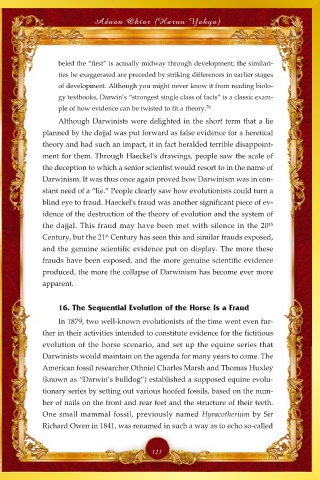Page 123 - Death of the Darwinist Dajjal System
P. 123
Adnan Oktar (Harun Yahya)
beled the “first” is actually midway through development; the similari-
ties he exaggerated are preceded by striking differences in earlier stages
of development. Although you might never know it from reading biolo-
gy textbooks, Darwin’s “strongest single class of facts” is a classic exam-
ple of how evidence can be twisted to fit a theory. 76
Although Darwinists were delighted in the short term that a lie
planned by the dajjal was put forward as false evidence for a heretical
theory and had such an impact, it in fact heralded terrible disappoint-
ment for them. Through Haeckel's drawings, people saw the scale of
the deception to which a senior scientist would resort to in the name of
Darwinism. It was thus once again proved how Darwinism was in con-
stant need of a “lie.” People clearly saw how evolutionists could turn a
blind eye to fraud. Haeckel's fraud was another significant piece of ev-
idence of the destruction of the theory of evolution and the system of
the dajjal. This fraud may have been met with silence in the 20 th
st
Century, but the 21 Century has seen this and similar frauds exposed,
and the genuine scientific evidence put on display. The more these
frauds have been exposed, and the more genuine scientific evidence
produced, the more the collapse of Darwinism has become ever more
apparent.
16. The Sequential Evolution of the Horse Is a Fraud
In 1879, two well-known evolutionists of the time went even fur-
ther in their activities intended to constitute evidence for the fictitious
evolution of the horse scenario, and set up the equine series that
Darwinists would maintain on the agenda for many years to come. The
American fossil researcher Othniel Charles Marsh and Thomas Huxley
(known as “Darwin’s bulldog”) established a supposed equine evolu-
tionary series by setting out various hoofed fossils, based on the num-
ber of nails on the front and rear feet and the structure of their teeth.
One small mammal fossil, previously named Hyracotherium by Sir
Richard Owen in 1841, was renamed in such a way as to echo so-called
121

